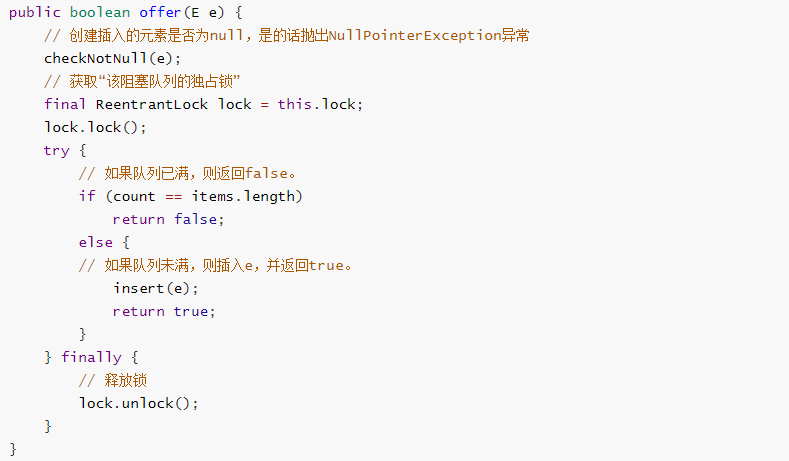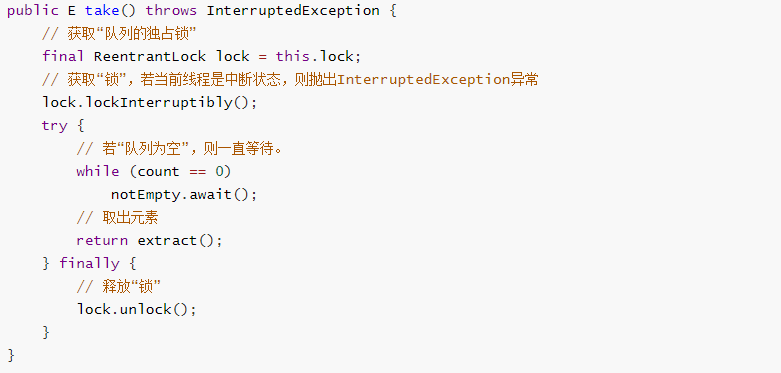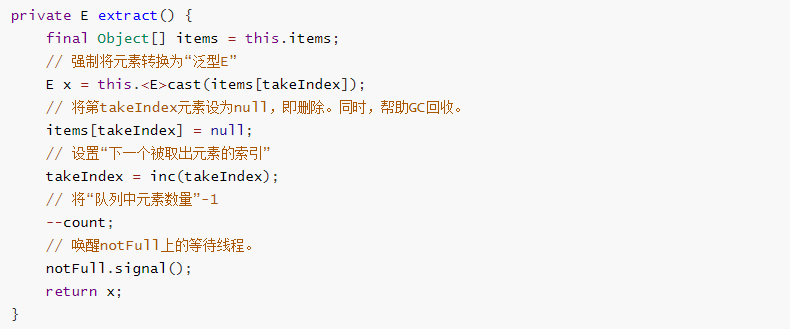ArrayBlockingQueue介绍
ArrayBlockingQueue是数组实现的线程安全的有界的阻塞队列。
线程安全是指,ArrayBlockingQueue内部通过“互斥锁”保护竞争资源,实现了多线程对竞争资源的互斥访问。
有界是指,ArrayBlockingQueue对应的数组是有界限的。
阻塞队列是指,多线程访问竞争资源时,当竞争资源已被某线程获取时,其它要获取该资源的线程需要阻塞等待。
ArrayBlockingQueue是按 FIFO原则对元素进行排序,元素都是从尾部插入到队列,从头部开始返回。
ArrayBlockingQueue原理和数据结构
-
ArrayBlockingQueue继承于AbstractQueue,并且它实现了BlockingQueue接口。
-
ArrayBlockingQueue内部是通过Object[]数组保存数据的,也就是说ArrayBlockingQueue本质上是通过数组实现的。ArrayBlockingQueue的大小即数组的容量,是创建ArrayBlockingQueue时指定的。
-
ArrayBlockingQueue与ReentrantLock是组合关系,ArrayBlockingQueue中包含一个ReentrantLock对象(lock)。ReentrantLock是可重入的互斥锁,ArrayBlockingQueue就是根据该互斥锁实现“多线程对竞争资源的互斥访问”。而且,ReentrantLock分为公平锁和非公平锁,关于具体使用公平锁还是非公平锁,在创建ArrayBlockingQueue时可以指定;而且,ArrayBlockingQueue默认会使用非公平锁。
-
ArrayBlockingQueue与Condition是组合关系,ArrayBlockingQueue中包含两个Condition对象(notEmpty和notFull)。而且,Condition又依赖于ArrayBlockingQueue而存在,通过Condition可以实现对ArrayBlockingQueue的更精确的访问
若某线程(线程A)要取数据时,数组正好为空,则该线程会执行notEmpty.await()进行等待;当其它某个线程(线程B)向数组中插入了数据之后,会调用notEmpty.signal()唤醒“notEmpty上的等待线程”。此时,线程A会被唤醒从而得以继续运行。
若某线程(线程H)要插入数据时,数组已满,则该线程会它执行notFull.await()进行等待;当其它某个线程(线程I)取出数据之后,会调用notFull.signal()唤醒“notFull上的等待线程”。此时,线程H就会被唤醒从而得以继续运行。
ArrayBlockingQueue函数列表
// 创建一个带有给定的(固定)容量和默认访问策略的 ArrayBlockingQueue。 ArrayBlockingQueue(int capacity) // 创建一个具有给定的(固定)容量和指定访问策略的 ArrayBlockingQueue。 ArrayBlockingQueue(int capacity, boolean fair) // 创建一个具有给定的(固定)容量和指定访问策略的 ArrayBlockingQueue,它最初包含给定 collection 的元素,并以 collection 迭代器的遍历顺序添加元素。 ArrayBlockingQueue(int capacity, boolean fair, Collection<? extends E> c) // 将指定的元素插入到此队列的尾部(如果立即可行且不会超过该队列的容量),在成功时返回 true,如果此队列已满,则抛出 IllegalStateException。 boolean add(E e) // 自动移除此队列中的所有元素。 void clear() // 如果此队列包含指定的元素,则返回 true。 boolean contains(Object o) // 移除此队列中所有可用的元素,并将它们添加到给定 collection 中。 int drainTo(Collection<? super E> c) // 最多从此队列中移除给定数量的可用元素,并将这些元素添加到给定 collection 中。 int drainTo(Collection<? super E> c, int maxElements) // 返回在此队列中的元素上按适当顺序进行迭代的迭代器。 Iterator<E> iterator() // 将指定的元素插入到此队列的尾部(如果立即可行且不会超过该队列的容量),在成功时返回 true,如果此队列已满,则返回 false。 boolean offer(E e) // 将指定的元素插入此队列的尾部,如果该队列已满,则在到达指定的等待时间之前等待可用的空间。 boolean offer(E e, long timeout, TimeUnit unit) // 获取但不移除此队列的头;如果此队列为空,则返回 null。 E peek() // 获取并移除此队列的头,如果此队列为空,则返回 null。 E poll() // 获取并移除此队列的头部,在指定的等待时间前等待可用的元素(如果有必要)。 E poll(long timeout, TimeUnit unit) // 将指定的元素插入此队列的尾部,如果该队列已满,则等待可用的空间。 void put(E e) // 返回在无阻塞的理想情况下(不存在内存或资源约束)此队列能接受的其他元素数量。 int remainingCapacity() // 从此队列中移除指定元素的单个实例(如果存在)。 boolean remove(Object o) // 返回此队列中元素的数量。 int size() // 获取并移除此队列的头部,在元素变得可用之前一直等待(如果有必要)。 E take() // 返回一个按适当顺序包含此队列中所有元素的数组。 Object[] toArray() // 返回一个按适当顺序包含此队列中所有元素的数组;返回数组的运行时类型是指定数组的运行时类型。 <T> T[] toArray(T[] a) // 返回此 collection 的字符串表示形式。 String toString()
ArrayBlockingQueue源码分析
下面从ArrayBlockingQueue的创建,添加,取出,遍历这几个方面对ArrayBlockingQueue进行分析。
1. 创建
下面以ArrayBlockingQueue(int capacity, boolean fair)来进行说明。

说明:
(01) items是保存“阻塞队列”数据的数组。它的定义如下:

(02) fair是“可重入的独占锁(ReentrantLock)”的类型。fair为true,表示是公平锁;fair为false,表示是非公平锁。 notEmpty和notFull是锁的两个Condition条件。它们的定义如下:

Lock的作用是提供独占锁机制,来保护竞争资源;而Condition是为了更加精细的对锁进行控制,它依赖于Lock,通过某个条件对多线程进行控制。 notEmpty表示“锁的非空条件”。当某线程想从队列中取数据时,而此时又没有数据,则该线程通过notEmpty.await()进行等待;当其它线程向队列中插入了元素之后,就调用notEmpty.signal()唤醒“之前通过notEmpty.await()进入等待状态的线程”。 同理,notFull表示“锁的满条件”。当某线程想向队列中插入元素,而此时队列已满时,该线程等待;当其它线程从队列中取出元素之后,就唤醒该等待的线程。
2. 添加
下面以offer(E e)为例,对ArrayBlockingQueue的添加方法进行说明。

说明:offer(E e)的作用是将e插入阻塞队列的尾部。如果队列已满,则返回false,表示插入失败;否则,插入元素,并返回true。
(01) count表示”队列中的元素个数“。除此之外,队列中还有另外两个遍历takeIndex和putIndex。takeIndex表示下一个被取出元素的索引,putIndex表示下一个被添加元素的索引。它们的定义如下:

(02) insert()的源码如下:

insert()在插入元素之后,会唤醒notEmpty上面的等待线程。inc()的源码如下:

若i+1的值等于“队列的长度”,即添加元素之后,队列满;则设置“下一个被添加元素的索引”为0。
下面以take()为例,对ArrayBlockingQueue的取出方法进行说明。

说明:take()的作用是取出并返回队列的头。若队列为空,则一直等待。 extract()的源码如下:

说明:extract()在删除元素之后,会唤醒notFull上的等待线程。
4. 遍历
下面对ArrayBlockingQueue的遍历方法进行说明。

Itr是实现了Iterator接口的类,它的源码如下:
private class Itr implements Iterator<E> { // 队列中剩余元素的个数 private int remaining; // Number of elements yet to be returned // 下一次调用next()返回的元素的索引 private int nextIndex; // Index of element to be returned by next // 下一次调用next()返回的元素 private E nextItem; // Element to be returned by next call to next // 上一次调用next()返回的元素 private E lastItem; // Element returned by last call to next // 上一次调用next()返回的元素的索引 private int lastRet; // Index of last element returned, or -1 if none Itr() { // 获取“阻塞队列”的锁 final ReentrantLock lock = ArrayBlockingQueue.this.lock; lock.lock(); try { lastRet = -1; if ((remaining = count) > 0) nextItem = itemAt(nextIndex = takeIndex); } finally { // 释放“锁” lock.unlock(); } } public boolean hasNext() { return remaining > 0; } public E next() { // 获取“阻塞队列”的锁 final ReentrantLock lock = ArrayBlockingQueue.this.lock; lock.lock(); try { // 若“剩余元素<=0”,则抛出异常。 if (remaining <= 0) throw new NoSuchElementException(); lastRet = nextIndex; // 获取第nextIndex位置的元素 E x = itemAt(nextIndex); // check for fresher value if (x == null) { x = nextItem; // we are forced to report old value lastItem = null; // but ensure remove fails } else lastItem = x; while (--remaining > 0 && // skip over nulls (nextItem = itemAt(nextIndex = inc(nextIndex))) == null) ; return x; } finally { lock.unlock(); } } public void remove() { final ReentrantLock lock = ArrayBlockingQueue.this.lock; lock.lock(); try { int i = lastRet; if (i == -1) throw new IllegalStateException(); lastRet = -1; E x = lastItem; lastItem = null; // only remove if item still at index if (x != null && x == items[i]) { boolean removingHead = (i == takeIndex); removeAt(i); if (!removingHead) nextIndex = dec(nextIndex); } } finally { lock.unlock(); } } }
ArrayBlockingQueue示例
import java.util.*; import java.util.concurrent.*; /* * ArrayBlockingQueue是“线程安全”的队列,而LinkedList是非线程安全的。 * * 下面是“多个线程同时操作并且遍历queue”的示例 * (01) 当queue是ArrayBlockingQueue对象时,程序能正常运行。 * (02) 当queue是LinkedList对象时,程序会产生ConcurrentModificationException异常。 */ public class ArrayBlockingQueueDemo1{ // TODO: queue是LinkedList对象时,程序会出错。 //private static Queue<String> queue = new LinkedList<String>(); private static Queue<String> queue = new ArrayBlockingQueue<String>(20); public static void main(String[] args) { // 同时启动两个线程对queue进行操作! new MyThread("ta").start(); new MyThread("tb").start(); } private static void printAll() { String value; Iterator iter = queue.iterator(); while(iter.hasNext()) { value = (String)iter.next(); System.out.print(value+", "); } System.out.println(); } private static class MyThread extends Thread { MyThread(String name) { super(name); } @Override public void run() { int i = 0; while (i++ < 6) { // “线程名” + "-" + "序号" String val = Thread.currentThread().getName()+i; queue.add(val); // 通过“Iterator”遍历queue。 printAll(); } } } }
其中一次运行结果:
ta1, ta1,
tb1, ta1,
tb1, ta1, ta2,
tb1, ta1, ta2, tb1, tb2,
ta2, ta1, tb2, tb1, ta3,
ta2, ta1, tb2, tb1, ta3, ta2, tb3,
tb2, ta1, ta3, tb1, tb3, ta2, ta4,
tb2, ta1, ta3, tb1, tb3, ta2, ta4, tb2, tb4,
ta3, ta1, tb3, tb1, ta4, ta2, tb4, tb2, ta5,
ta3, ta1, tb3, tb1, ta4, ta2, tb4, tb2, ta5, ta3, tb5,
tb3, ta1, ta4, tb1, tb4, ta2, ta5, tb2, tb5, ta3, ta6,
tb3, ta4, tb4, ta5, tb5, ta6, tb6,
结果说明:如果将源码中的queue改成LinkedList对象时,程序会产生ConcurrentModificationException异常。
LinkedBlockingQueue VS ArrayBlockingQueue
1. LinkedBlockingQueue 由于拥有两把锁,它的操作粒度更细,在并发程度高的时候,相对于只有一把锁的 ArrayBlockingQueue 性能会更好。
2. ArrayBlockingQueue的内部结构是“数组”的形式,LinkedBlockingQueue 的内部是用链表实现的,ArrayBlockingQueue 没有链表所需要的“节点”,空间利用率更高。